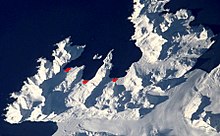Leith Harbor
Leith Harbor was a whaling base in Leith Harbor Bay on the north coast of South Georgia , built and operated by Christian Salvesen & Company , Edinburgh . The base was in use from 1909 to 1965 and was the largest of seven whaling stations in South Georgia. It was in Stromness Bay near the entrance on the banks of a glacial stream. William Storm Harrison was prominent in its founding .
history
At the beginning of the 20th century, South Georgia became the world's largest whaling center. There were coastal bases at Grytviken (operated from 1904 to 1964), Leith Harbor (1909 to 1965), Ocean Harbor (1909 to 1920), Husvik (1910 to 1960), Stromness (1913 to 1961) and Prince Olav Harbor (1917 to 1931 ). Among the companies involved were the Compañía Argentina de Pesca , the Christian Salvesen Ltd. ( UK ), Albion Star (South Georgia) Ltd. ( Falkland Islands ), the Norwegian whaling companies Hvalfangerselskap Ocean , Tønsberg Hvalfangeri and Sandefjord Hvalfangerselskap and the Southern Whaling and Sealing Company from South Africa . In the final seasons of whaling around South Georgia, Grytviken and Leith Harbor were rented by the Japanese companies Kokusai Gyogyo Kabushike Kaisha and Nippon Suisan Kaisha (1963/64 and 1963-65, respectively).
Leith Harbor boasted a hospital, a library, a cinema and a narrow-gauge railway (plus railways on South Georgia ). Due to its purpose, the place also had a factory and a Flens platform.
During the Second World War , all whaling stations were closed except for Grytviken and Leith Harbor. Most of the British and Norwegian factories and whaling ships were destroyed by the Germans, while the remainder were drafted under Allied command. British Magistrates W. Barlas and Al Fleuret took over the defense of the island during the war. The Royal Navy armed the liner Queen of Bermuda to patrol the waters around South Georgia. In addition, two 102 mm cannons were set up in key locations to protect the access to Cumberland Bay and Stromness Bay, ie to Grytviken and Leith Harbor. These still-existing batteries were manned by volunteers from among the Norwegian whalers who had been trained for this purpose.
In March 1982, South Georgia became embroiled in the Falklands War when a group of around fifty Argentines occupied the abandoned Leith Harbor whaling station on the pretext of being scrap dealers. On March 25, 1982, 32 members of an Argentine special unit followed and landed in Leith Harbor. As a result, South Georgia came under Argentine de facto control, bases were set up in Grytviken and Leith Harbor.
On April 25, 72 British soldiers were sent to the island after demonstrating their firepower, forcing the Argentine garrison in Grytviken to give up without a fight. The next day the Argentines surrendered in Leith Harbor, also without a fight.
today
A gun emplacement is on the hill behind the station, as is Hansen Point , where the original 102mm cannon is still in position. In the center is the so-called "Portuguese cemetery". Like the whaling stations of Stromness, Husvik and Prince Olav Harbor, Leith Harbor has been closed to tourists for security reasons. The danger comes from dilapidated and asbestos-contaminated buildings. Visitors are not allowed to be more than 200 meters away from the buildings and facilities.
See also
Web links
- Photos of Leith Harbor on Jim McLaren: South Georgia Pictures (private website, English)
- More photos of Bill Howieson, on Jim McLaren's website
- More photos by John Johnston McKay, on Jim McLaren's website
- On the narrow-gauge railway on Railways of the Far South (English)
Coordinates: 54 ° 8 ′ 30.6 ″ S , 36 ° 41 ′ 15.4 ″ W.



